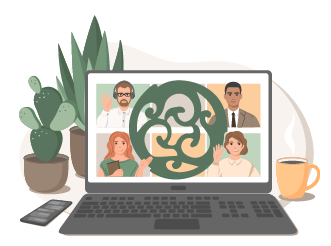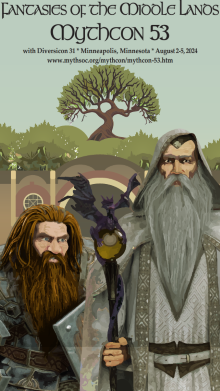Loading...
Document Type
Paper
Event Website
http://www.mythsoc.org/mythcon/mythcon-51.htm
Start Date
31-7-2021 1:30 PM
End Date
31-7-2021 2:15 PM
Description
In "On Fairy-stories," J. R. R. Tolkien defined and defended the genre of fantasy by quoting and then explicating his poem, "Mythopoeia." Tolkien's theory of mythopoeic literature can be applied to his own fiction, but, increasingly, scholars are applying it to other texts including superhero films and contemporary fantasy novels (Holdier, Kane). In this presentation, I argue that three of Kingfisher's series, the Clocktaur War, Saint of Steel, and Paladin, set in and around Anuket City, fit some of the characteristics of mythopoeic fantasy identified by Tolkien while swerving notably from others. Thus, Kingfisher's fantasy is similar to work by the writers Faye Ringel interviewed for her essay, "Women Fantasists: In the Shadow of the Ring." Performing her own feminist swerve on Harold Bloom's Anxiety of Influence, Ringel concludes that while the "women fantasists accept some of Tolkien's premises, they differ strongly with him on the subject of women's roles" (165). Tolkien's necessary characteristics for a mythopoeic text involve textual elements and reader response. A mythopoeic fantasy is set in a secondary world that is internally consistent; the "magic" must "be taken seriously," and the best of the genre involves "the Consolation of the Happy Ending" (32-33;75). Tolkien makes it clear that this genre is for readers who appreciate it, no matter what their age, challenging the assumption at the time that fairy stories were only suitable for children. Recovery, escape, and consolation are how mythopoeic fantasies impact readers. Tolkien makes it clear that fairies (elves) are not required while his epilogue places the genre firmly in his Christian belief system. Some of the elements in Kingfisher's series that are mythopoeic are: the coherence of the secondary world, across three series with different characters; a version of Faërie, called the Vagrant Lands; the presence of magic, called "wonderworking." Elements which swerve decisively from Tolkien's criteria are the lack of kings and heroes; the presence of religious institutions and their orders; polytheism; the widespread distribution of wonderworking along with the lack of wizards; the focus on female protagonists. powerful male characters. Since Kingfisher is writing fantasy romance rather than epic fantasy, the protagonists include a forger, a perfumer, and a widowed housekeeper who inherits a magic sword. These swerves from Tolkien's definition strengthen my experience of recovery, escape, and consolation as a reader, responses that grew stronger during my re-reading of her work during the first year of the pandemic.
Tech Mod: Leslie Donovan.
Included in
Writing Against the Grain: T. Kingfisher's Feminist Mythopoeic Fantasy
In "On Fairy-stories," J. R. R. Tolkien defined and defended the genre of fantasy by quoting and then explicating his poem, "Mythopoeia." Tolkien's theory of mythopoeic literature can be applied to his own fiction, but, increasingly, scholars are applying it to other texts including superhero films and contemporary fantasy novels (Holdier, Kane). In this presentation, I argue that three of Kingfisher's series, the Clocktaur War, Saint of Steel, and Paladin, set in and around Anuket City, fit some of the characteristics of mythopoeic fantasy identified by Tolkien while swerving notably from others. Thus, Kingfisher's fantasy is similar to work by the writers Faye Ringel interviewed for her essay, "Women Fantasists: In the Shadow of the Ring." Performing her own feminist swerve on Harold Bloom's Anxiety of Influence, Ringel concludes that while the "women fantasists accept some of Tolkien's premises, they differ strongly with him on the subject of women's roles" (165). Tolkien's necessary characteristics for a mythopoeic text involve textual elements and reader response. A mythopoeic fantasy is set in a secondary world that is internally consistent; the "magic" must "be taken seriously," and the best of the genre involves "the Consolation of the Happy Ending" (32-33;75). Tolkien makes it clear that this genre is for readers who appreciate it, no matter what their age, challenging the assumption at the time that fairy stories were only suitable for children. Recovery, escape, and consolation are how mythopoeic fantasies impact readers. Tolkien makes it clear that fairies (elves) are not required while his epilogue places the genre firmly in his Christian belief system. Some of the elements in Kingfisher's series that are mythopoeic are: the coherence of the secondary world, across three series with different characters; a version of Faërie, called the Vagrant Lands; the presence of magic, called "wonderworking." Elements which swerve decisively from Tolkien's criteria are the lack of kings and heroes; the presence of religious institutions and their orders; polytheism; the widespread distribution of wonderworking along with the lack of wizards; the focus on female protagonists. powerful male characters. Since Kingfisher is writing fantasy romance rather than epic fantasy, the protagonists include a forger, a perfumer, and a widowed housekeeper who inherits a magic sword. These swerves from Tolkien's definition strengthen my experience of recovery, escape, and consolation as a reader, responses that grew stronger during my re-reading of her work during the first year of the pandemic.
Tech Mod: Leslie Donovan.
https://dc.swosu.edu/mythcon/mc51/schedule/11



Comments
Recorded Session